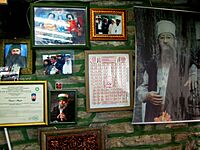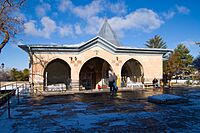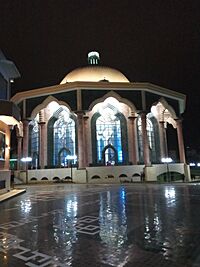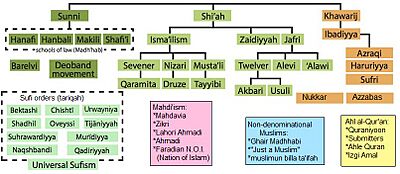Bektashi Order facts for kids

Emblem of Bektashism
|
|
| Abbreviation | Bektashiyyah/Bektashism |
|---|---|
| Type | Dervish order |
| Headquarters | World Headquarters of the Bektashi, Tirana (previously Haji Bektash Veli Complex, Nevşehir) |
|
Region
|
Albania, Bulgaria, Greece, Kosovo, North Macedonia, Turkey, other Albanian diaspora (Italy, United States) and Turkish diaspora (Germany, France, Austria, Belgium) |
|
Dedebaba
|
Baba Mondi |
|
Key people
|
|
| Website | Official website: https://kryegjyshataboterorebektashiane.org/ |
The Bektashi Order or Bektashism is an Islamic Sufi mystic order originating in the 13th-century Ottoman Empire. It is named after the saint Haji Bektash Veli. The Bektashian community is currently led by Baba Mondi, their eighth Bektashi Dedebaba and headquartered in Tirana, Albania. Collectively, adherents of Bektashism, are called Bektashians or simply Bektashis.
Originally one of many Sufi orders within Sunni Islam, by the 16th century the order adopted some tenets of Twelver Shia Islam, including a veneration of ʿAlī, the son-in-law of Muhammad, and the Twelve Imams; as well as a variety of syncretic beliefs. The Bektashis acquired political importance in the 15th century, when the order dominated the Janissary Corps. After the foundation of the Turkish Republic, Kemal Atatürk banned religious institutions that weren't part of the Directorate of Religious Affairs and the community's headquarters relocated to Albania. Salih Nijazi was the last Dede in Turkey whilst also being the first one in Albania. The order became involved in Albanian politics, and some of its members, including Ismail Qemali, were major leaders of the Albanian National Awakening.
Bektashis believe in the Ismah of the Islamic Prophets and messengers, the Twelve Imams, the Fourteen Infallibles and the current Dedebabas. In addition to the spiritual teachings of Haji Bektash Veli, the Bektashi order was later significantly influenced during its formative period by the Hurufis (in the early 15th century), the Qalandariyya stream of Sufism, figures like Ahmad Yasawi, Yunus Emre, Shah Ismail, Shaykh Haydar, Nesimi, Pir Sultan Abdal, Gül Baba, Sarı Saltık and to varying degrees more broadly the Shia belief system circulating in Anatolia during the 14th to 16th centuries. The mystical practices and rituals of the Bektashi order were systematized and structured by Balım Sultan in the 16th century.
According to a 2005 estimate made by Reshat Bardhi, there are over seven million Bektashis worldwide, though more recent studies put the figure as high as 20 million. In Albania, they make up 9% of the Muslim population and 5% of the country's population. An additional 12.5 million Bektashis live in Turkey. Bektashis are mainly found throughout Anatolia, the Balkans and among Ottoman-era Greek Muslim communities. The term "Alevi–Bektashi" is currently a widely and frequently used expression in the religious discourse of Turkey as an umbrella term for the two religious groups of Alevism and Bektashism.
Contents
History
Origins and establishment

The Bektashiyya originated in Anatolia as the followers of the 13th-century scholar Bektash. The doctrines and rituals of the Bektashiyya were codified by the mystic Balim Sultan, who is considered the pīr al-thānī ('the Second Elder') by Bektashis.
It was originally founded as a Sufi movement. The branch became widespread in the Ottoman Empire, their lodges scattered throughout Anatolia as well as in the Balkans. It became the official order of the Janissary corps, the elite infantry corp of the Ottoman Army. Therefore, they also became mainly associated with Anatolian and Balkan Muslims of Eastern Orthodox convert origin, mainly Albanians and northern Greeks (although most leading Bektashi babas were of southern Albanian origin). In 1826, the Bektashi order was banned throughout the Ottoman Empire by Sultan Mahmud II for having close ties with the Janissary corps. Many Bektashi dervishes were exiled, and some were executed. Their tekkes were destroyed and their revenues were confiscated. This decision was supported by the Sunni religious elite as well as the leaders of other, more orthodox, Sufi orders. Bektashis slowly regained freedom with the coming of the Tanzimat era. After the foundation of the Turkish Republic, Kemal Atatürk shut down the lodges in 1925. Consequently, the Bektashi leadership moved to Albania and established their headquarters in the city of Tirana. Among the most famous followers of Bektashi in the 19th century Balkans were Ali Pasha and Naim Frashëri.
Dedebabate
After lodges in Turkey were shut down, the order's headquarters moved to Albania. On 20 March 1930, Sali Njazi was elected as the First Dedebaba of the Bektashi community. Njazi established the Bektashi World Headquarters in Tirana. Its construction was finished in 1941 during the Italian occupation of Albania. Njazi promoted Bektashi Islam by introducing major ceremonies at popular tekkes. After he was murdered, Ali Riza succeeded him as the Dedebaba.
Despite the negative effect of the ban of lodges on Bektashi culture, most Bektashis in Turkey have been generally supportive of secularism to this day, since these reforms have relatively relaxed the religious intolerance that had historically been shown against them by the official Sunni establishment.
In the Balkans the Bektashi order had a considerable impact on the Islamization of many areas, primarily Albania and Bulgaria, as well as parts of Macedonia, particularly among Ottoman-era Greek Muslims from western Greek Macedonia such as the Vallahades. By the 18th century Bektashism began to gain a considerable hold over the population of southern Albania and northwestern Greece (Epirus and western Greek Macedonia). Following the ban on Sufi orders in the Republic of Turkey, the Bektashi community's headquarters was moved from Hacıbektaş in central Anatolia, to Tirana, Albania. In Albania, the Bektashi community declared its separation from the Sunni community and they were perceived ever after as a distinct Islamic sect rather than a branch of Sunni Islam. Bektashism continued to flourish until the Second World War. After the communists took power in 1945, several babas and dervishes were executed and a gradual constriction of Bektashi influence began. Ultimately, in 1967 all tekkes were shut down when Enver Hoxha banned all religious practice. When this ban was rescinded in 1990 the Bektashism reestablished itself, although there were few left with any real knowledge of the spiritual path. Nevertheless, many "tekkes" (lodges) operate today in Albania. The most recent head of the order in Albania was Hajji Reshat Bardhi Dedebaba (1935–2011) and the main tekke has been reopened in Tirana. In June 2011 Baba Edmond Brahimaj was chosen as the head of the Bektashi order by a council of Albanian babas. Today sympathy for the order is generally widespread in Albania where approximately 20% of Muslims identify themselves as having some connection to Bektashism.
There are also important Bektashi communities among the Albanian communities of North Macedonia and Kosovo, the most important being the Arabati Baba Teḱe in the city of Tetovo, which was until recently under the guidance of Baba Tahir Emini (1941–2006). Following the death of Baba Tahir Emini, the dedelik of Tirana appointed Baba Edmond Brahimaj (known as Baba Mondi), formerly head of the Turan Tekke of Korçë, to oversee the Harabati baba tekke. A splinter branch of the order has recently sprung up in the town of Kičevo which has ties to the Turkish Bektashi community under Haydar Ercan Dede rather than Tirana. A smaller Bektashi tekke, the Dikmen Baba Tekkesi, is in operation in the Turkish-speaking town of Kanatlarci, North Macedonia that also has stronger ties with Turkey's Bektashis. In Kosovo, the relatively small Bektashi community has a tekke in the town of Gjakovë and is under the leadership of Baba Mumin Lama and it recognizes the leadership of Tirana.
In Bulgaria, the türbes of Kıdlemi Baba, Ak Yazılı Baba, Demir Baba and Otman Baba function as heterodox Islamic pilgrimage sites and before 1842 were the centers of Bektashi tekkes.
Bektashis continue to be active in Turkey and their semi-clandestine organizations can be found in Istanbul, Ankara and İzmir. There are currently two rival claimants to the dedebaba in Turkey: Mustafa Eke and Haydar Ercan.
A large functioning Bektashi tekke was also established in the United States in 1954 by Baba Rexheb. This tekke is found in the Detroit suburb of Taylor and the tomb (türbe) of Baba Rexheb continues to draw pilgrims of all faiths.
Beliefs
Bektashis believe in God and follow all the prophets. Bektashis claim the heritage of Haji Bektash Veli, who was a descendant of Ali, Husayn ibn Ali, Ali ibn Husayn Zayn al-Abidin and other Imams. Therefore, Bektashis follow the teachings of Haji Bektash, who preached about the Twelve Imams. Bektashis differ from other Muslims by also following the Fourteen Innocents, who either died in infancy or were martyred with Husayn. Abbas ibn Ali is also an important figure in Bektashi Islam, and Bektashi Muslims visit Mount Tomorr to honor him during an annual pilgrimage to the Abbas Ali Türbe on August 20–25.
In addition to the Muslim daily five prayers, Bektashi Muslims have two specific prayers, one at dawn and one at dusk for the welfare of all humanity. Bektashism places much emphasis on the concept of Wahdat al-Wujud (Arabic: وحدة الوجود, romanized: Unity of Being) that was formulated by Ibn Arabi.
Malakat is an important text of Bektashi written by Haji Bektash. Bektashis also follow the Quran and Hadith.
Bektashis follow the modern-day Bektashi Dedebabate, currently headed by Baba Mondi. Bektashis consider the dedebaba as their leader overseeing the entire branch.
Bektashism is also heavily permeated with Shiite concepts, such as the marked reverence of Ali, the Twelve Imams, and the ritual commemoration of Ashura marking the Battle of Karbala. The old Persian holiday of Nowruz is celebrated by Bektashis as Ali's birthday (see also Nevruz in Albania).
The Bektashi Order is a Sufi order and shares much in common with other Islamic mystical movements, such as the need for an experienced spiritual guide—called a baba in Bektashi parlance — as well as the doctrine of "the four gates that must be traversed": the "Sharia" (religious law), "Tariqah" (the spiritual path), "Marifa" (true knowledge), "Haqiqa" (truth).
There are many other practices and ceremonies that share similarities with other faiths, such as a ritual meal (muhabbet) and yearly confession of sins to a baba (magfirat-i zunub مغفرة الذنوب). Bektashis base their practices and rituals on their non-orthodox and mystical interpretation and understanding of the Quran and the prophetic practice (Sunnah). They have no written doctrine specific to them, thus rules and rituals may differ depending on under whose influence one has been taught. Bektashis generally revere Sufi mystics outside of their own order, such as ibn Arabi, al-Ghazali and Rumi, who are close in spirit to them despite many of being from more mainstream Islamic backgrounds.
Rakia, a fruit brandy, is used as a sacramental element by the Bektashi Order, and Alevi Jem ceremonies, where it is referred to as "dem".
Poetry and literature
Poetry plays an important role in the transmission of Bektashi spirituality. Several important Ottoman-era poets were Bektashis, and Yunus Emre, the most acclaimed poet of the Turkish language, is generally recognized as a subscriber to the Bektashi order.
Like many Sufis, the Bektashis were quite lax in observing daily Muslim laws. The Bektashis in the Balkans adapted such Christian practices as the ritual sharing of bread and the confession of sins. Bektashi mystical writings made a rich contribution to Sufi poetry.
A poem from Bektashi poet Balım Sultan (died c. 1517/1519):
İstivayı özler gözüm, (My eye seeks out repose,)
Seb'al-mesânîdir yüzüm, (my face is the 'oft repeated seven (i.e. the Sura Al-Fatiha),)
Ene'l-Hakk'ı söyler sözüm, (My words proclaim "I am the Truth",)
Miracımız dardır bizim, (Our ascension is (by means of) the scaffold,)
Haber aldık muhkemattan, (We have become aware through the "firm letters",)
Geçmeyiz zâttan sıfattan, (We will not abandon essence or attributes,)
Balım nihan söyler Hakk'tan, (Balım speaks arcanely of God)
İrşâdımız sırdır bizim. (Our teaching is a mystery.)
Community hierarchy
Like most other Sufi orders, Bektashism is initiatic, and members must traverse various levels or ranks as they progress along the spiritual path to the Reality. The Turkish names are given below, followed by their Arabic and Albanian equivalents.
- First-level members are called aşıks عاشق (Albanian: ashik). They are those who, while not having taken initiation into the order, are nevertheless drawn to it.
- Following initiation (called nasip), one becomes a mühip محب (Albanian: muhib).
- After some time as a mühip, one can take further vows and become a dervish.
- The next level above dervish is that of baba. The baba (lit. father) (Albanian: atë) is considered to be the head of a tekke and qualified to give spiritual guidance (irshad إرشاد).
- Above the baba (Albanian: gjysh) is the rank of halife-baba (or dede, grandfather).
- The dedebaba (Albanian: kryegjysh) is traditionally considered to be the highest ranking authority in the Bektashi Order. Traditionally the residence of the dedebaba was the Pir Evi (The Saint's Home) which was located in the shrine of Hajji Bektash Wali in the central Anatolian town of Hacıbektaş (aka Solucakarahüyük), known as the Hajibektash complex.
Traditionally there were twelve of these hierarchical rankings, the most senior being the dedebaba (great-grandfather).
Administration
In Albania, the World Headquarters of the Bektashi (Albanian: Kryegjyshata) divides the country into 6 different administrative districts (similar to Christian parishes and patriarchates), each of which is called a gjyshata.
- The Gjyshata of Gjirokastra (headquarters: tekke of Asim Bab): the regions of Gjirokastra, Saranda and Tepelena.
- The Gjyshata of Korça (headquarters: tekke of Turan): the regions of Korça, Devoll, Pogradec and Kolonja, including Leskovik.
- The Gjyshata of Kruja (headquarters: tekke of Fushë Kruj): the regions of Kruja, Kurbin, Bulqiza, Dibra, Mat, Shkodra and Durrës.
- The Gjyshata of Elbasan (headquarters: tekke of Baba Xhefai): the regions of Elbasan, Gramsh, Peqin, Lushnja, Kavaja, and Librazhd, including Përrenjas.
- The Gjyshata of Vlora (headquarters: tekke of Kusum Bab): the regions of Vlora, Mallakastra, Fier, including Patos and Roskovec.
- The Gjyshata of Berat (headquarters: tekke of Prisht): the regions of Berat, Skrapar and Përmet.
During the 1930s, the six gjyshata of Albania set up by Sali Njazi were:
- Kruja, headquartered at the tekke of Fushë-Krujë
- Elbasan, headquartered at the tekke of Krastë, Dibër
- Korça, headquartered at the tekke of Melçan
- Gjirokastra, headquartered at the tekke of Asim Baba
- Prishta, representing Berat and part of Përmet
- Vlora, headquartered at the tekke of Frashër
National headquarters in other countries are located in:
There is also a Bektashi office in Brussels, Belgium.
World Bektashi Congress
The World Bektashi Congress, also called the National Congress of the Bektashi, a conference during which members of the Bektashi Community make important decisions, has been held in Albania several times. Since 1945, it has been held exclusively in Tirana. The longest gap between two congresses lasted from 1950 to 1993, when congresses could not be held during Communist rule in Albania. A list of congresses is given below.
| No. | Congress | Date | Location | Notes |
|---|---|---|---|---|
| 1 | First National Congress of the Bektashi | 14–17 January 1921 | tekke of Prishta in the Skrapar region | The name Komuniteti Bektashian (Bektashi community) was adopted. |
| 2 | Second National Congress of the Bektashi | 8–9 July 1924 | Gjirokastra | |
| 3 | Third National Congress of the Bektashi | 23 September 1929 | tekke of Turan near Korça | The Bektashi declared themselves to be a religious community autonomous from other Islamic communities. |
| 4 | Fourth National Congress of the Bektashi | 5 May 1945 | Tirana | Xhafer Sadiku Dede was made kryegjysh (or dedebaba), and the influential Baba Faja Martaneshi, a communist collaborator, was made secretary general. |
| 5 | Fifth National Congress of the Bektashi | 16 April 1950 | Tirana | |
| 6 | Sixth National Congress of the Bektashi | 19–20 July 1993 | Tirana | |
| 7 | Seventh National Congress of the Bektashi | 23–24 September 2000 | Tirana | |
| 8 | Eighth National Congress of the Bektashi | 21 September 2005 | Tirana | |
| 9 | Ninth National Congress of the Bektashi | 6 July 2009 | Tirana |
List of Dedebabas
This section lists the Dedebabas (Supreme Leaders) of the Bektashi Order.
In Turkey (before 1930)
List of Bektashi Dedebabas (mostly based in Hacıbektaş, Anatolia), prior to the 1925 exodus of the Bektashi Order from Turkey to Albania:
- Haji Bektash Veli (1282-1341)
- Hidër Llalla (1341-1361)
- Resul Balli (1361-1441)
- Jusuf Balli (1400s)
- Myrsel Balli (1400s)
- Balım Sultan (1509-1516)
- Sersem Ali Dede Baba (1551-1569)
- Eihaxh Ahmed Dede Baba (1569-1569)
- Ak Abdulla Dede Baba (1569-1596)
- Kara Halil Dede Baba (1596-1628)
- Eihaxh Vahdeti Dede (1628-1649)
- Eihaxh Sejjid Mustafa Dede Baba (1649-1675)
- Ibrahim Agjah Dede Baba (1675-1689)
- Halil Ibrahim Dede Baba (1689-1714)
- Haxhi Hasan Dede Baba (1714-1736)
- Hanzade Mehmed Kylhan Dede (1736-1759)
- Sejjid Kara Ali Dede Baba (1759-1783)
- Sejjid Dede Baba (1783-1790)
- Haxhi Mehmed Nuri Dede Baba (1790-1799)
- Haxhi Halil Haki Dede Baba (1799-1813)
- Mehmed Nebi Dede Baba (1813-1834)
- Haxhi Ibrahim Dede Baba (1834-1835)
- Sejjid Haxhi Mahmud Dede Baba (1835-1846)
- Saatxhi Dede Baba (1846-1848)
- Sejjid Hasan Dede Baba (1848-1849)
- Elhaxh Ali Turabi Dede Baba (1849-1868)
- Haxhi Hasan Dede Baba (1868-1874)
- Perishan Hafizali Dede Baba (1874-1879)
- Mehmed Ali Hilmi Dede Baba (1879-1907)
- Haxhi Mehmed Ali Dede Baba (1907-1910)
- Haxhi Fejzullah Dede Baba (1910-1913)
- Sali Njazi Dede Baba (1913-1925)
In Albania (1930–present)
List of Bektashi Dedebabas following the 1925 exodus of the Bektashi Order from Turkey to Albania:
Religious figures
- Abaz Hilmi, Dede Baba, of the Tekke of Frashër (1887–1947)
- Abbas ibn Ali
- Abdullah Baba of Melçan (1786–1857 (–1853?))
- Abedin Baba of Leskovik
- Adem Baba of Prizren (d. 1894)
- Adem Vexh-hi Baba of Gjakova (1841–1927)
- Ahmet Baba of Prishta (d. 1902)
- Ahmet Baba of Turan (1854–1928)
- Ahmet Karadja
- Ahmet Myftari, Dede Baba (1916–1980)
- Ahmet Sirri Baba of Mokattam (1895–1963)
- Ali Baba of Berat
- Ali Baba of Tomorr (1900–1948)
- Ali Baba Horasani of Fushë Kruja (d. 1562)
- Ali Haqi Baba of Gjirokastra (1827–1907)
- Ali Riza of Elbasan, Dede Baba (1876–1944)
- Alush Baba of Frashër (c. 1816–1896)
- Arshi Baba of Durballi Sultan (1906–2015)
- Arshi Baba of Gjirokastra (d. 1621)
- Asim Baba of Gjirokastra (d. 1796)
- Balim Sultan of Dimetoka (1457–1517)
- Dylgjer Hysejni of Elbasan (b. 1959)
- Edmond Brahimaj, Dede Baba (1910–1947)
- Faja Martaneshi Baba
- Fetah Baba of Backa
- Hajdar Hatemi Baba of Gjonëm (early 19th century)
- Hajdër Baba of Kardhiq (d. 1904)
- Haji Bektash Veli (1248–1337) (Albanian: Haxhi Bektashi Veli; Turkish: Hacı Bektaş Veli)
- Hasan Dede of Përmet
- Haxhi Baba Horasani of Përmet (d. 1620)
- Haxhi Baba of Fushë Kruja
- Hidër Baba of Makedonski Brod
- Hysen Baba of Melçan (d. 1914)
- Hysen Kukeli Baba of Fushë Kruja (1822–1893)
- Ibrahim Baba of Qesaraka (d. 1930)
- Ibrahim Xhefai Baba of Elbasan (d. 1829)
- Iljaz Vërzhezha, Dervish (d. 1923)
- Kamber Ali, Dede Baba (1869–1950)
- Kasem Baba of Kastoria (late 15th century)
- Kusum Baba of Vlora
- Lutfi Baba of Mokattam (1849–1942)
- Mehmet Baba of Fushë Kruja (1882–1934)
- Meleq Shëmbërdhenji Baba (1842–1918)
- Muharrem Baba of Frashër (early 19th century)
- Muharrem Mahzuni Baba of Durballi Sultan (d. 1867)
- Myrteza Baba of Fushë Kruja (1912–1947)
- Qazim Baba of Elbasan (1891–1962)
- Qazim Baba of Gjakova (1895–1981)
- Qamil Baba of Gllava (d. 1946)
- Reshat Bardhi, Dede Baba (1935–2011)
- Rexheb Baba of Gjirokastra (1901–1995)
- Salih Baba of Matohasanaj (19th to 20th centuries)
- Salih Nijazi, Dede Baba (1876–1941)
- Sari Saltik
- Seit Baba of Durballi Sultan (d. 1973)
- Selim Kaliçani Baba of Martanesh (1922–2001)
- Selim Ruhi Baba of Gjirokastra (1869–1944)
- Selman Xhemali Baba of Elbasan (d. 1949)
- Sersem Ali Baba of Tetova (d. 1569)
- Shemimi Baba of Fushë Kruja (1748–1803)
- Sulejman Baba of Gjirokastra (d. 1934)
- Tahir Nasibi Baba of Frashër (d. 1835)
- Tahir Baba of Prishta (19th century)
- Xhafer Sadiku, Dede Baba (1874–1945)
Gallery
-
Bektashi tekke of Gjakova, Kosovo, established in 1790
-
Demir Baba Teke near Sveshtari, Bulgaria (16th century)
See also
 In Spanish: Bektashi para niños
In Spanish: Bektashi para niños

















